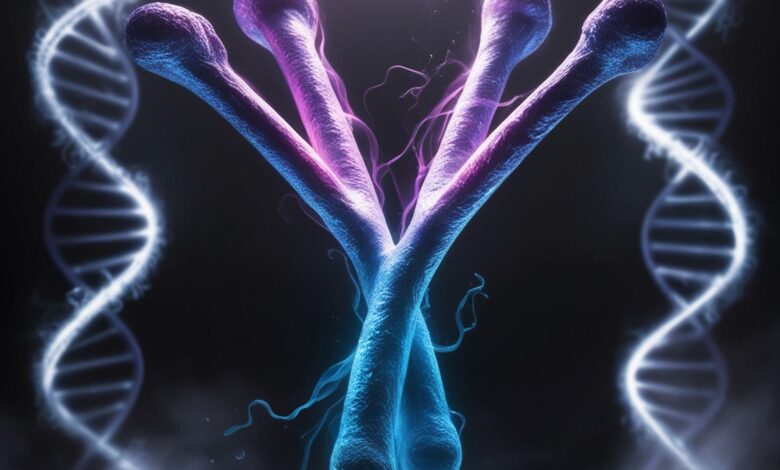Y Chromosome’s Extinction: End of Men?

Imagine a future where men no longer exist. At the same time, this might sound like the premise of a science fiction story, but recent scientific research points to a potential reality where the “End of Men” is more than a metaphor. Evidence suggests that the Y chromosome, which is only found in males, responsible for male characteristics, is deteriorating at an alarming rate, posing a potential threat to the existence of men. This shift could have profound effects on men and women and the future of human society as we know it.
DNA, Genes, and Chromosomes: The Foundation Under Threat
To understand the potential “End of Men,” it’s crucial to grasp the fundamentals of DNA, genes, and chromosomes. DNA carries genetic instructions, genes code for specific traits, and chromosomes organize these genes within our cells. The Y chromosome is unique to males and plays a crucial role in defining male traits and reproductive abilities.
Why Are Men’s Genes at Risk While Women’s Are Not?
Significant differences between men’s and women’s chromosomes impact genetic stability. Women have two X chromosomes, allowing a genetic backup if one X chromosome has issues. Men, however, possess only one X and one Y chromosome, and the Y chromosome is much smaller and contains fewer genes, leaving it more vulnerable to mutations and genetic loss. This susceptibility to degradation puts men at a higher risk of genetic instability, potentially accelerating the “End of Men.”
Interestingly, women’s DNA seems to be getting stronger and healthier with each generation. Some studies suggest this may be due to natural selection, as healthier reproductive traits are passed on, strengthening the overall female genetic pool.
The Shrinking Y Chromosome: Evidence for Men’s Potential Extinction
Recent research reveals a concerning trend: the Y chromosome is losing genetic material over generations. Scientists at Kansas State University found that the Y chromosome has already lost 97% of its original genes, with only 3% remaining. If this pattern persists, a future without men “End of Men”—could become a biological reality. This raises a terrifying question: What will happen to women and the future of humanity if there are no men left?
What Could a World Without Men Look Like?
If the Y chromosome continues to shrink, society may face a world where men are absent. This possibility raises profound questions: How would humanity adapt? Could science step in to save the Y chromosome, or might alternative reproductive methods be needed to sustain future generations?
Is the Decline of the Y Chromosome Part of Life’s Natural Cycle?
Every living being is part of the cycle of life and death. Cells age, mutations occur, and eventually, all organisms reach their biological limits and it’s possible that the gradual decline of the Y chromosome is one aspect of this cycle. Scientists are still investigating whether the degradation of the Y chromosome is a fatal flaw in male biology or if it plays a role in a broader natural process. The question remains open: will the “End of Men” become an unavoidable aspect of human evolution?
An Islamic Perspective on the End of Men and Nature’s Harmony
From an Islamic perspective, the extinction of men would disrupt the balance established by Allah. In Islam, men and women are viewed as complementary parts of a whole, both essential to preserving the natural order. The Quran speaks to the wisdom of creating pairs in all things, a design rooted in divine insight:
“And of everything We have created pairs, that you may remember (the Grace of Allah)”
(Quran 51:49)
If men were to disappear, it would disturb this balance. However, Islam also teaches that Allah’s wisdom is beyond human comprehension, reminding us to reflect on the fragility of life and the importance of divine guidance.
How Can Humanity Address the Threat to Men’s Survival?
Though this research highlights a concerning issue, it also opens doors to new possibilities. Advances in genetic engineering might allow scientists to repair or replace deteriorating parts of the Y chromosome, potentially preventing the “End of Men.” In addition, methods like cloning and advanced IVF could support reproduction if the Y chromosome becomes nonviable. Humanity has shown remarkable resilience in facing challenges, and addressing the “End of Men” may drive innovation in genetics and medicine.
A Time for Reflection: Confronting the Potential End of Men
The possibility of men’s extinction forces us to confront fundamental questions about life, purpose, and human existence. Is the degradation of the Y chromosome part of a divine plan, or is it a biological flaw to be corrected? Can science find solutions in time, and how might society evolve without men?
While answers remain elusive, this research offers a profound wake-up call. By working with the scientific community, drawing wisdom from faith, and uniting to find solutions, we can face these challenges together and work to safeguard humanity’s future.
Y Chromosome’s Extinction: End of Men?




👍👍